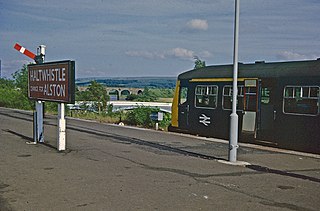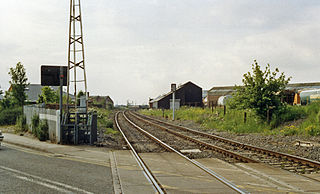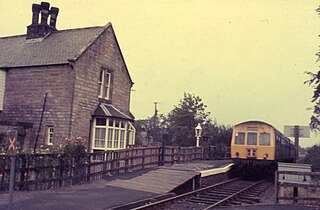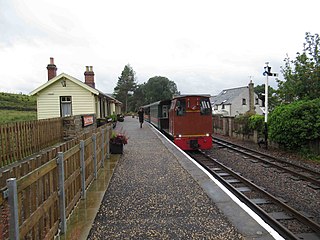
Bank Foot is a Tyne and Wear Metro station, serving the suburb of Kenton Bank Foot, Newcastle upon Tyne in Tyne and Wear, England. It joined the network as a terminus station on 10 May 1981, following the opening of the second phase of the network, between South Gosforth and Bank Foot. The station was used by 0.11 million passengers in 2017–18, making it the third-least-used station on the network, after St Peter's and Pallion.

Wansbeck Road is a Tyne and Wear Metro station, serving the suburbs of Coxlodge and Gosforth, Newcastle upon Tyne in Tyne and Wear, England. It joined the network on 10 May 1981, following the opening of the second phase of the network, between South Gosforth and Bank Foot.
The Blyth and Tyne Railway was a railway company in Northumberland, England, incorporated by Act of Parliament on 30 June 1852. It was created to unify the various private railways and waggonways built to carry coal from the Northumberland coalfield to Blyth and the River Tyne, which it took control of on 1 January 1853. Over time, the railway expanded its network to reach Morpeth (1857/8), North Seaton (1859), Tynemouth (1860/1), Newcastle upon Tyne (1864), and finally Newbiggin-by-the-Sea (1872). It became part of the much larger North Eastern Railway in 1874.

Regent Centre is a Tyne and Wear Metro station in Zone B, serving the suburb of Gosforth, Newcastle upon Tyne. It joined the network on 10 May 1981, following the opening of the second phase of the network, between South Gosforth and Bank Foot.

The Alston Line was a 13-mile (21 km) single-track branch line, which linked Haltwhistle in Northumberland with Alston in Cumbria.

The Leicester–Burton upon Trent line is a freight-only railway line in England linking the Midland Main Line near Leicester to the Derby to Birmingham line at Burton upon Trent. The line was built by the Midland Railway, which had acquired the Leicester and Swannington Railway in 1847, improving it and extending it. It opened throughout in 1849. The line connected an exceptional number of collieries and industrial premises, and several industrial branch lines were built radiating from it. Swadlincote was already an established community engaged in industry and there was a complex of branch lines there. The passenger service on the line was discontinued in 1964, and much of the mining-based industry has closed down; quarrying is the dominant residual originating traffic. There are proposals to reopen the passenger service, and these are under review at present (2022).

Coxlodge is an area situated between Fawdon, Gosforth and Kenton in Newcastle upon Tyne, in the county of Tyne and Wear, England. Until 1974 it was in Northumberland.

The Ponteland Railway was a 7-mile (11 km) single-track branch line, which linked Gosforth in Tyne and Wear with Ponteland in Northumberland. A 1+1⁄4-mile (2 km) sub-branch line also ran between Ponteland and Darras Hall.
Walker was a railway station on the Riverside Branch which ran between Byker and Willington Quay. The station served Walker in Newcastle upon Tyne.

Kenton Bank was a railway station on the Ponteland Railway, which ran between South Gosforth and Ponteland, with a sub-branch line to Darras Hall. The station served Kenton in Newcastle upon Tyne.

Featherstone Park was a railway station on the Alston Branch Line, which ran between Haltwhistle and Alston. The station, situated 3 miles (5 km) south-west of Haltwhistle, served the villages of Featherstone and Rowfoot in Northumberland.

Lambley was a railway station on the Alston Branch Line, which ran between Haltwhistle and Alston. The station, situated 4+3⁄4 miles (8 km) south-west of Haltwhistle, served the village of Lambley in Northumberland.

Ponteland was a railway station on the Ponteland Railway, which ran between South Gosforth and Ponteland, with a sub-branch line to Darras Hall. It served Ponteland in Northumberland.
Callerton was a railway station on the Ponteland Railway, which ran between South Gosforth and Ponteland, with a sub-branch line to Darras Hall. The station served Woolsington in Newcastle upon Tyne.
Coxlodge was a railway station on the Ponteland Railway, which ran between South Gosforth and Ponteland, with a sub-branch line to Darras Hall. The station served Coxlodge and Fawdon in Newcastle upon Tyne.
West Gosforth was a railway station on the Ponteland Railway, which ran between South Gosforth and Ponteland, with a sub-branch line to Darras Hall. The station served Gosforth in Newcastle upon Tyne.

Coanwood was a railway station on the Alston Branch Line, which ran between Haltwhistle and Alston. The station, situated 4 miles (6 km) south-west of Haltwhistle, served the village of Coanwood in Northumberland.

Slaggyford was a railway station on the Alston Line, which ran between Haltwhistle and Alston. The station served the village of Slaggyford in Northumberland.

Hart railway station was a station that served the villages of Hart and Crimdon in County Durham, England.
Brook Street Halt railway station served the town of Rhosllanerchrugog, Denbighshire, Wales, from 1905 to 1915 on the Pontcysyllte branch.













